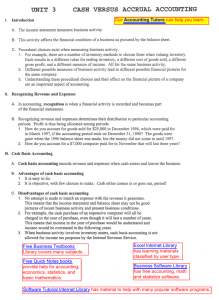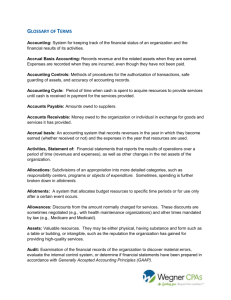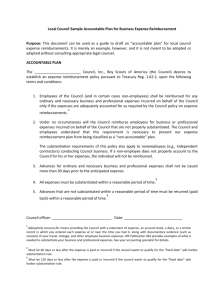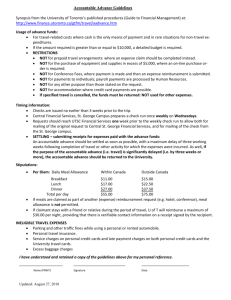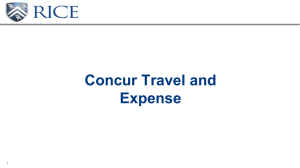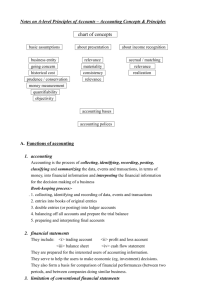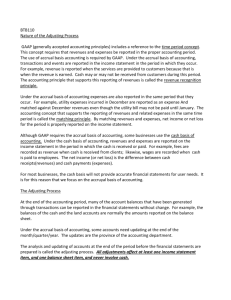Concept 8 ()
advertisement
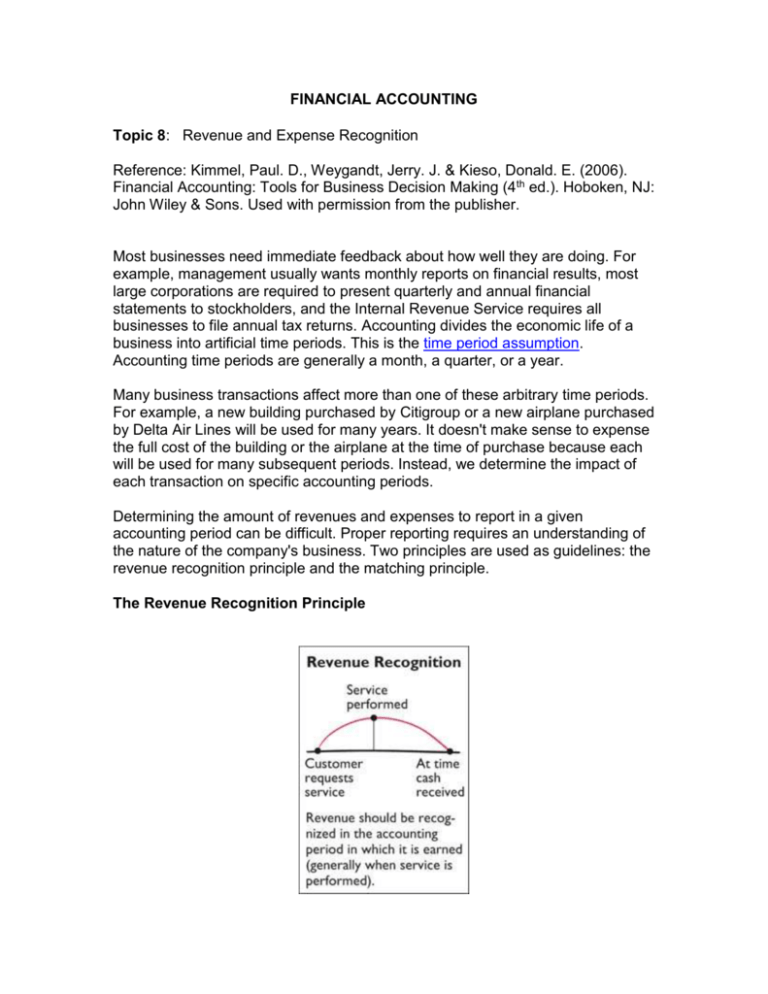
FINANCIAL ACCOUNTING Topic 8: Revenue and Expense Recognition Reference: Kimmel, Paul. D., Weygandt, Jerry. J. & Kieso, Donald. E. (2006). Financial Accounting: Tools for Business Decision Making (4th ed.). Hoboken, NJ: John Wiley & Sons. Used with permission from the publisher. Most businesses need immediate feedback about how well they are doing. For example, management usually wants monthly reports on financial results, most large corporations are required to present quarterly and annual financial statements to stockholders, and the Internal Revenue Service requires all businesses to file annual tax returns. Accounting divides the economic life of a business into artificial time periods. This is the time period assumption. Accounting time periods are generally a month, a quarter, or a year. Many business transactions affect more than one of these arbitrary time periods. For example, a new building purchased by Citigroup or a new airplane purchased by Delta Air Lines will be used for many years. It doesn't make sense to expense the full cost of the building or the airplane at the time of purchase because each will be used for many subsequent periods. Instead, we determine the impact of each transaction on specific accounting periods. Determining the amount of revenues and expenses to report in a given accounting period can be difficult. Proper reporting requires an understanding of the nature of the company's business. Two principles are used as guidelines: the revenue recognition principle and the matching principle. The Revenue Recognition Principle The revenue recognition principle requires that companies recognize revenue in the accounting period in which it is earned. In a service company, revenue is considered to be earned at the time the service is performed. To illustrate, assume Conrad Dry Cleaners cleans clothing on June 30, but customers do not claim and pay for their clothes until the first week of July. Under the revenue recognition principle, Conrad earns revenue in June when it performs the service, not in July when it receives the cash. At June 30 Conrad would report a receivable on its balance sheet and revenue in its income statement for the service performed. The Matching Principle In recognizing expenses, a simple rule is followed: “Let the expenses follow the revenues.” Thus, expense recognition is tied to revenue recognition. Applied to the preceding example, this means that the salary expense Conrad incurred in performing the cleaning service on June 30 should be reported in the same period in which it recognizes the service revenue. The critical issue in expense recognition is determining when the expense makes its contribution to revenue. This may or may not be the same period in which the expense is paid. If Conrad does not pay the salary incurred on June 30 until July, it would report salaries payable on its June 30 balance sheet. The practice of expense recognition is referred to as the matching principle because it dictates that efforts (expenses) be matched with accomplishments (revenues). Illustration 1 shows these relationships. Illustration 1 GAAP relationships in revenue and expense recognition Accrual Accrual-basis accounting means that transactions that change a company's financial statements are recorded in the periods in which the events occur. For example, using the accrual basis means that companies recognize revenues when earned (the revenue recognition principle) rather than when they receive cash. Likewise, under the accrual basis, companies recognize expenses when incurred (the matching principle) rather than when paid. An alternative to the accrual basis is the cash basis. Under cash-basis accounting, companies record revenue only when cash is received. They record expense only when cash is paid. The cash basis of accounting is prohibited under generally accepted accounting principles. Why? Because it does not record revenue when earned, thus violating the revenue recognition principle. Similarly, it does not record expenses when incurred, which violates the matching principle. Illustration 2 compares accrual-based numbers and cash-based numbers. Suppose that Fresh Colors paints a large building in 2006. In 2006 it incurs and pays total expenses (salaries and paint costs) of $50,000. It bills the customer $80,000, but does not receive payment until 2007. On an accrual basis, Fresh Colors reports $80,000 of revenue during 2006 because that is when it is earned. The company matches expenses of $50,000 to the $80,000 of revenue. Thus, 2006 net income is $30,000 ($80,000 − $50,000). The $30,000 of net income reported for 2006 indicates the profitability of Fresh Colors' efforts during that period. Illustration 2 Accrual versus cash basis accounting If, instead, Fresh Paint were to use cash-basis accounting, it would report $50,000 of expenses in 2006 and $80,000 of revenues during 2007. As shown in Illustration 2, it would report a loss of $50,000 in 2006 and would report net income of $80,000 in 2007. Clearly, the cash-basis measures are misleading because the financial performance of the company would be misstated for both 2006 and 2007.

